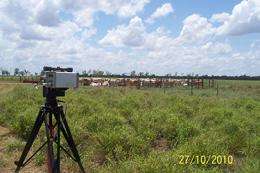Research sheds new light on methane emissions from the northern beef herd

New CSIRO research indicates that the amount of methane emitted from cattle fed on tropical grasses in northern Australia is up to 30 per cent less than figures currently used to calculate the northern cattle industry’s contribution to Australia’s greenhouse gas accounts.
Speaking at today’s Lansdown Field Day near Townsville, Queensland, CSIRO research leader Dr Ed Charmley said the findings would help to refine the nation’s greenhouse gas accounting.
“Measurements from cattle in CSIRO’s custom-built respiration chambers show that Brahman cattle fed a wide range of tropical grasses emit up to 30 per cent less methane than previously determined.
“While you always have to be cautious in extending lab data to the field and across an industry, we have been able to cross-check our findings with methane detecting laser systems used in the field.
“These findings, while not changing the actual emissions, could have significant implications for calculating the emission footprint of the northern cattle industry and also for Australia’s greenhouse gas accounts.
“Methods used to determine these national greenhouse gas accounts are regularly reviewed and if the new data are confirmed via this review process, future accounts will be adjusted to reflect the lower emissions for the northern beef herd,” Dr Charmley said.
With about half of the nation’s beef herd located in northern Australia, current greenhouse gas accounts indicate that methane from the northern cattle industry contributes about 4.5 per cent of Australia’s greenhouse gas emissions.
As a by-product of digesting plants, ruminant livestock such as sheep and cattle produce methane and, of those, beef cattle produce the most – about 200 grams a day, or about 1.5 tonnes of CO2 equivalents per animal every year.
“CSIRO research also shows that northern cattle fed on a diet of predominantly Leucaena, a legume tree, emit less methane than cattle grazing on tropical grasses,” Dr Charmley said.
“What this nutrition research is showing is that there can be win-win scenarios for the industry and the environment if we can redirect the breakdown of plant material in a way that reduces the amount of methane produced while improving the amount of energy or weight gain that animals get from their feed.
“We are addressing cattle methane emissions from several angles – from examining the gut microbes that produce methane from ingested pasture and alternative diets, to a landscape focus on northern Australia’s extensive grazing systems using state-of-the-art technologies, such as lasers and wireless sensor networks, to measure and model cattle methane emissions under tropical conditions.”
The Lansdown Research Station is a key part of CSIRO’s broader research programs on livestock production and emissions reduction in agriculture.
Provided by CSIRO














